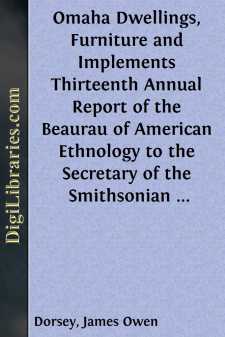Categories
- Antiques & Collectibles 13
- Architecture 36
- Art 48
- Bibles 22
- Biography & Autobiography 813
- Body, Mind & Spirit 142
- Business & Economics 28
- Children's Books 16
- Children's Fiction 13
- Computers 4
- Cooking 94
- Crafts & Hobbies 4
- Drama 346
- Education 46
- Family & Relationships 57
- Fiction 11829
- Games 19
- Gardening 17
- Health & Fitness 34
- History 1377
- House & Home 1
- Humor 147
- Juvenile Fiction 1873
- Juvenile Nonfiction 202
- Language Arts & Disciplines 88
- Law 16
- Literary Collections 686
- Literary Criticism 179
- Mathematics 13
- Medical 41
- Music 40
- Nature 179
- Non-Classifiable 1768
- Performing Arts 7
- Periodicals 1453
- Philosophy 64
- Photography 2
- Poetry 896
- Political Science 203
- Psychology 42
- Reference 154
- Religion 513
- Science 126
- Self-Help 84
- Social Science 81
- Sports & Recreation 34
- Study Aids 3
- Technology & Engineering 59
- Transportation 23
- Travel 463
- True Crime 29
Omaha Dwellings, Furniture and Implements Thirteenth Annual Report of the Beaurau of American Ethnology to the Secretary of the Smithsonian Institution 1891-1892, Government Printing Office, Washington, 1896 pages 263-288
Categories:
Description:
Excerpt
DWELLINGS.
The primitive domiciles of the Omaha were chiefly (1) lodges of earth or, more rarely, of bark or mats, and (2) skin lodges or tents. It may be observed that there were no sacred rites connected with the earth lodge-building or tent-making among the Omaha and Ponka.
Earth Lodges.
When earth lodges were built, the people did not make them in a tribal circle, each man erecting his lodge where he wished; yet kindred commonly built near one another.
The earth lodges were made by the women, and were intended principally for summer use, when the people were not migrating or going on the hunt. Those built by the Omaha and Ponka were constructed in the following manner: The roof was supported by two series of vertical posts, forked at the top for the reception of the transverse connecting pieces of each series. The number in each series varied according to the size of the lodge; for a small lodge only four posts were erected in the inner series, for an ordinary lodge eight were required, and ten generally constituted the maximum. When Mr. Say visited the Kansa Indians, he occupied a lodge in which twelve of these posts placed in a circle formed the outer series, and eight longer ones constituted the inner series, also describing a circle. The wall was formed by setting upright slabs of wood back of the outer posts all around the circumference of the lodge. These slabs were not over 6 feet in height, and their tops met the cross timbers on which the willow posts rested. Stocks of hard willow about 2 inches in diameter rested with their butts on the tops of the upright slabs and extended on the cross timbers nearly to the summit. These poles were very numerous, touching one another and extending all around in a radiating manner, supporting the roof like rafters. The rafters were covered with grass about a foot thick; and over the whole lodge, including the sides or slabs, earth was piled from a foot to 2 feet in depth. Such a covering lasted generally about twenty years. A hole in the middle served as an exit for the smoke.
Fig.306.—Yellow Smoke's earth lodge.In addition to the lodge proper there was a covered way about 10 feet long and 5 feet wide, the entrance to which had a covering of tanned or dried buffalo hides. This covering consisted of two hides hanging side by side, with the inner borders slightly overlapping. They were fastened to the passageway at the top and at the outer sides, but were loose at the bottom where they overlapped. This part was raised by a person entering the lodge. A similar covering was placed at the interior end of the passageway.
Subsequently to 1855, the Omaha dwelt in three villages composed of earth lodges, as follows: (1) Biku′de, a village near the agency; (2) Windja′ge, Standing Hawk's village, near the Presbyterian mission house; and (3) Jaüa′te ("Wood Eaters,") named after an insect found under the bark of trees Sanssouci's village, near the town of Decatur, Nebraska.
Earth lodges were generally used for large gatherings, such as feasts, councils, or dances....



